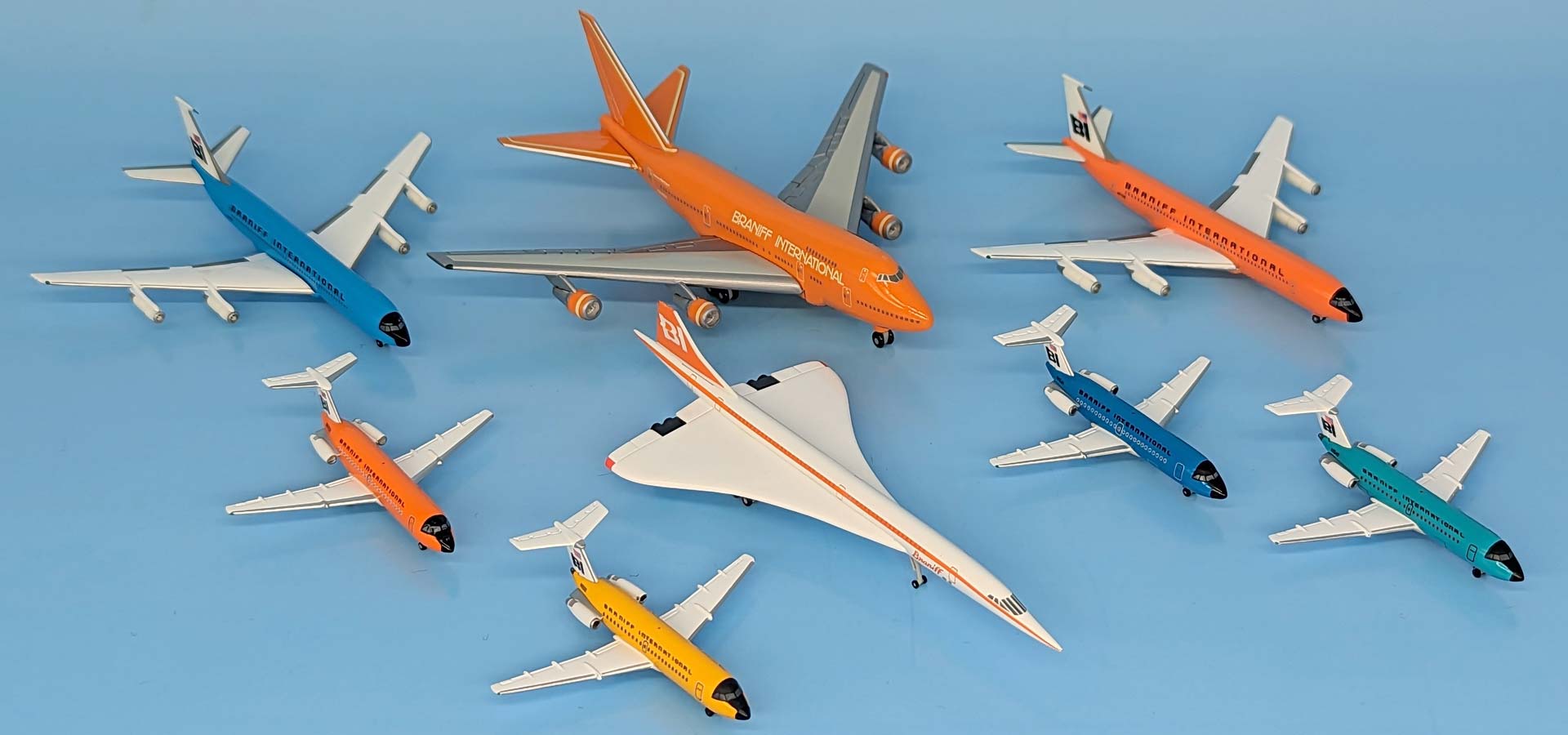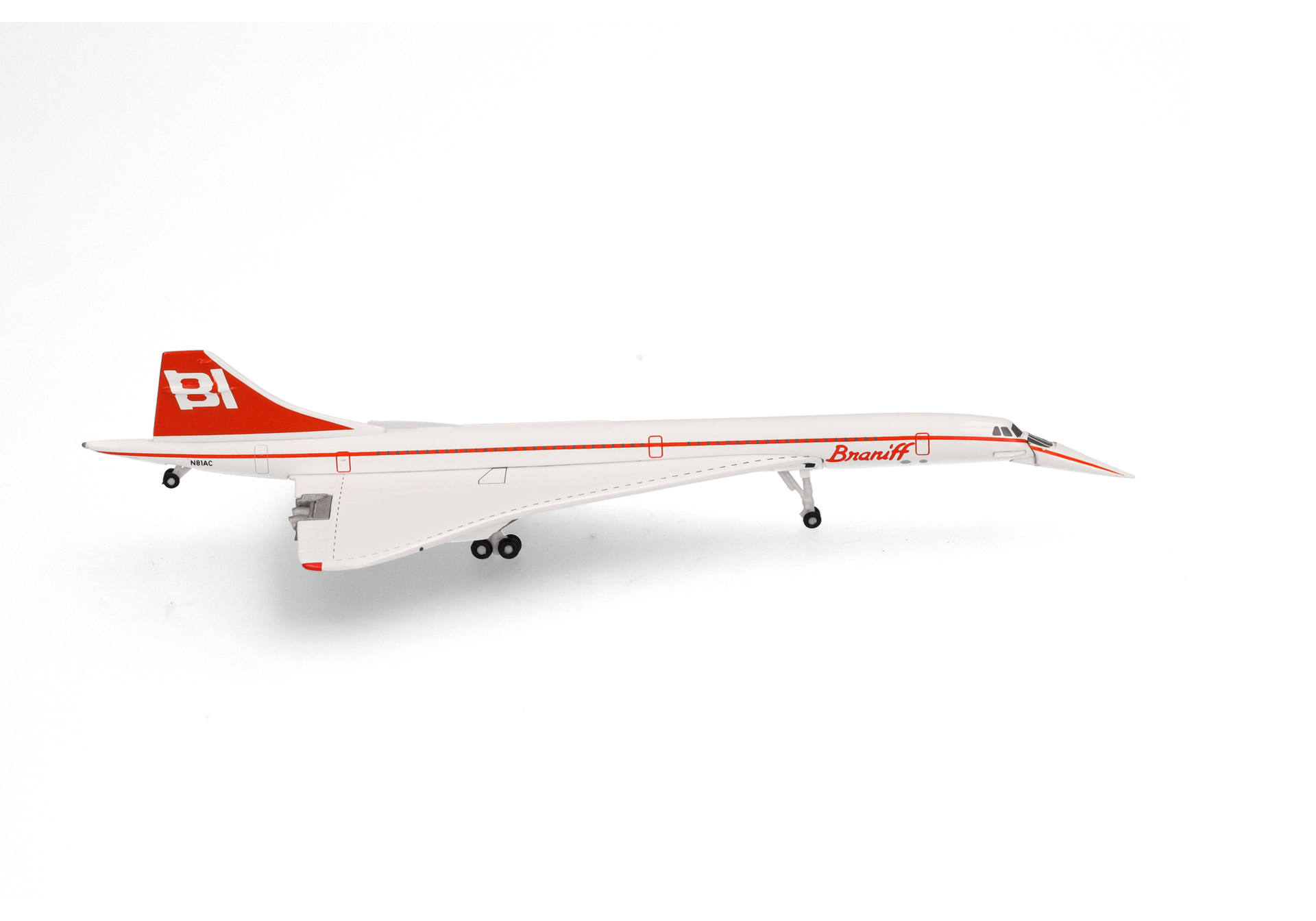Braniff flying colors
The US airline, which was founded in 1928 as Braniff Airlines, later flying as Braniff International Airways, and from 1965 simply as Braniff International, gained immortal status with the colorful corporate image it introduced in 1965. With the then revolutionary campaign "The end of the plain plane", the airline defied all previous conventions in aircraft livery design, and etched its brand onto the mind of the flying public at airports across North America, and later in Europe and Asia as well. The colorful models of the US airline are extremely popular collector's items. You can find an overview of all the models released by Herpa to date here.
Different to the rest
Renowned creative minds, such as designer Mary Wells Lawrence, architect Alexander Girard, fashion designer Emilio Pucci, and shoe designer Beth Levine, developed a new corporate image for the airline in the mid-1960s, which included having the fleet fly in a variety of colors. The "Jelly Bean Fleet", named after the well-known candy, surprised travelers with airliners that were sometimes beige, sometimes ochre, orange, turquoise, blue, lemon yellow, or lavender. Such a break with the principle of a uniform corporate design, which many airlines have meanwhile dared to copy, was extremely bold at the time and far ahead of its time.
Overview of all of Herpa’s Braniff models
Although this avant-garde advance in airliner livery design could not prevent the end of the airline in 1982, a result of deregulation and rising fuel prices, it nevertheless made Braniff a popular and unforgettable airline to this day, and a major brand in aviation. Aircraft spotters and model collectors do usually love a splash of color, and so Braniff models were oft requested by Wings collectors at Herpa very early on.
The model of the Braniff Boeing 747SP "Baby Orange" was delivered in its own showcase under item number 511605.
First model distributed exclusively
In 1998, the time had come: Exclusively for the "Wings500 Gold Club", the forerunner of today's collectors' forum "Wings900 - www.wings900.com, Herpa produced the Boeing 747SP N604BN, named "Baby Orange", referring to the shortened version of the jumbo and its color, in the 1:500 scale. It was one of four Boeing 747SPs that were used by the airline from 1979 onwards. The model was the only one from Braniff that Herpa still produced in the so-called "Classic Wings Edition" with the rollable landing gear. It came with its own showcase as item number 511605 in the "Exclusive Series".
The showcase of the Braniff Boeing 747SP "Baby Orange" shows a parking position in front of a terminal backdrop. It is Herpa’s model of the shortened Braniff jumbo registered N604BN in the 1:500 scale. It was produced exclusively for the "Wings500" club in 1998.
It was not until 2004 that Herpa continued its Braniff model series. Two Boeing 707-300s and an Aerospital Concorde were produced, also for exclusive distribution. While the Boeing 707-300 registered N7097 (item no. 514200) in turquoise and the 707 with the registration N7102 (item no. 514217) in orange flew from 1966 to 1973 at Braniff in various bright colors, one might falsely assume that the Concorde model was an imaginary model.
The 1:500 Braniff models of the Boeing 707-300 with the registrations N7097 in turquoise and N7102 in orange were produced exclusively for the "Braniff Airline Expo" at the Parco Museum in Shibuya / Japan in 2004.
You would be right regarding the Braniff livery. Between 1979 and 1980, however, the airline actually flew Concordes leased from Air France and British Airways. They flew overland between Dallas and Washington-Dulles at subsonic speed, but supersonic for the transatlantic flight to and from Europe and were then taken over by the Braniff crew in the USA. However, no Concorde was ever painted in Braniff colors. For flights within the USA, only the registration of the European aircraft was changed by pasting over the front part of the identifiers ("G-BO" or "F-BV"). For example, the original registration G-BOAC became N81AC, as displayed by the Herpa model (507059). The paintwork depicted on the Herpa model, which was obviously not true to the original, corresponded to contemporary artistic designs.
This 1:500 scale model of a Braniff Aerospatiale Concorde with the registration N81AC was produced exclusively for "Braniff Airline Expo" at the Parco Museum in Shibuya/Japan. However, the original never flew in Braniff colors, being leased from British Airways.
Jelly-Bean paintwork for the retail collection
In 2013 and 2019, two BAC 1-11-200 Braniff models appeared in the Herpa Collection, in limited editions, in the 1:500 scale. They featured four of the total of seven colors of the jelly bean paint scheme specified in 1965 in the rebranding campaign. In 2013, an orange model with the registration N1552 (item no. 523677) appeared first, followed by a blue model with the identification N1541 (item no. 524087). Six years later, models in ochre with the registration N1550 (533003), and in turquoise with the identification N1549 (533010) were added.
These models of the Braniff BAC 1-11-200 in ochre, orange, turquoise, and blue appeared in the retail collection.
The model of the oldest Braniff aircraft also appeared in 2019. The Convair CV-340 Liner was produced in a limited 1:200 scale edition and sold under item number 559621. This aircraft type was part of the Braniff fleet from 1952 to 1967, one of 26 examples in total.
The model of the airline's first aircraft type, a Convair CV-340 Liner with the registration N3406, was released in 2019 as a 1:200 scale limited edition collection model.
Colorful packaging
Not only the models, but also the packaging of the exclusive 1:500 scale models were designed to be extremely colorful and varied. All these models were characterized by a very precise reproduction of the colorful paintwork and the striking design for which Braniff had won fame and meanwhile legend status. This makes these miniature aircraft not only colorful and beautiful gems in any model collection, but also a tribute to the innovative and artistic appearance of the airline, unmistakable to this day.
In keeping with the model, Herpa designed the packaging for the models to be colorful and unusual, such as here for the Braniff Boeing 747SP "Baby Orange", the Braniff Aerospatiale Concorde, and the two Braniff Boeing 707-300s.
It is not without reason that there have been four relaunch attempts to revive the airline, all of which have failed. What has remained, however, is the preservation and utilization of the Braniff brand, for example in the form of a Braniff hotel in the corporate design of the former airline, and with furniture made from old aircraft parts, near Dallas Love Field airport. Braniff is an iconic brand, and the popularity of the Herpa models of this great airline is proof of that.




















